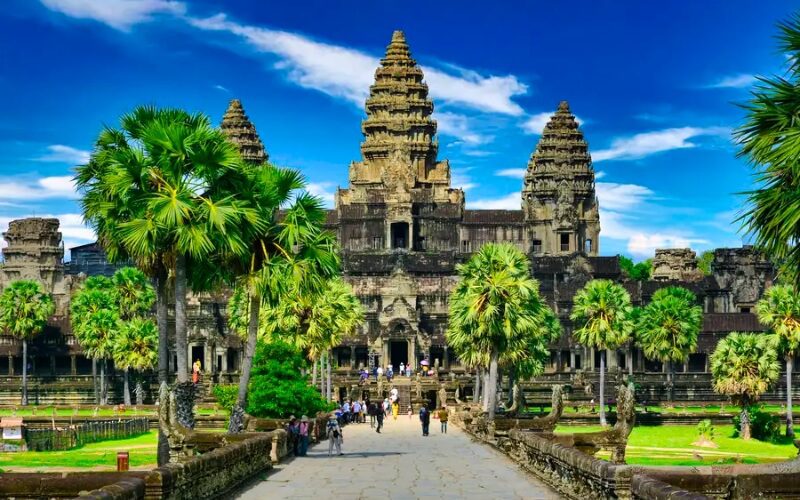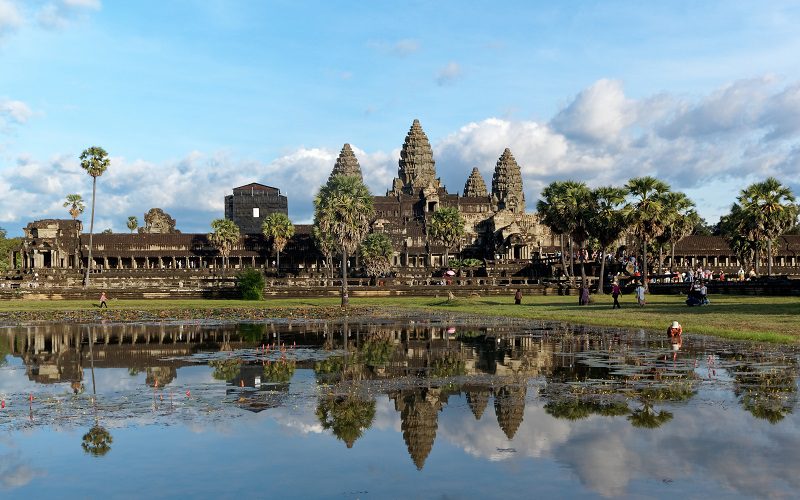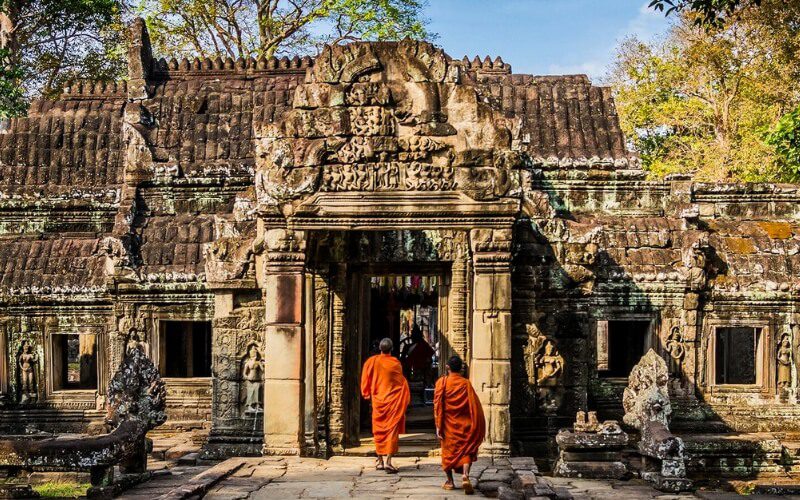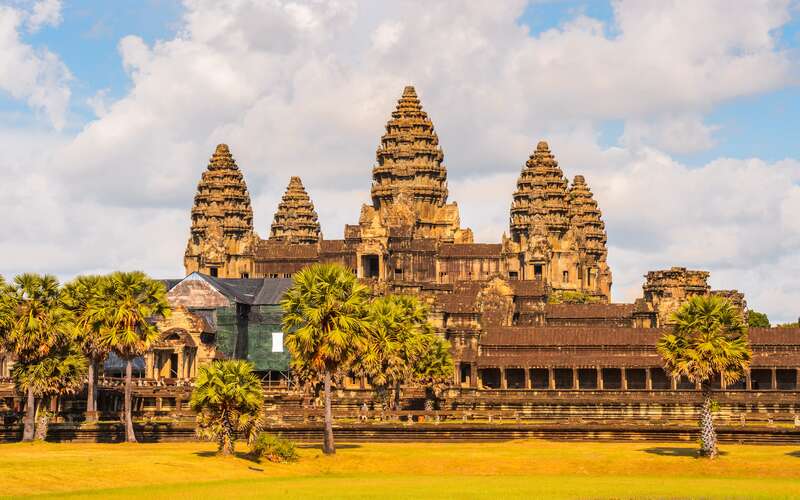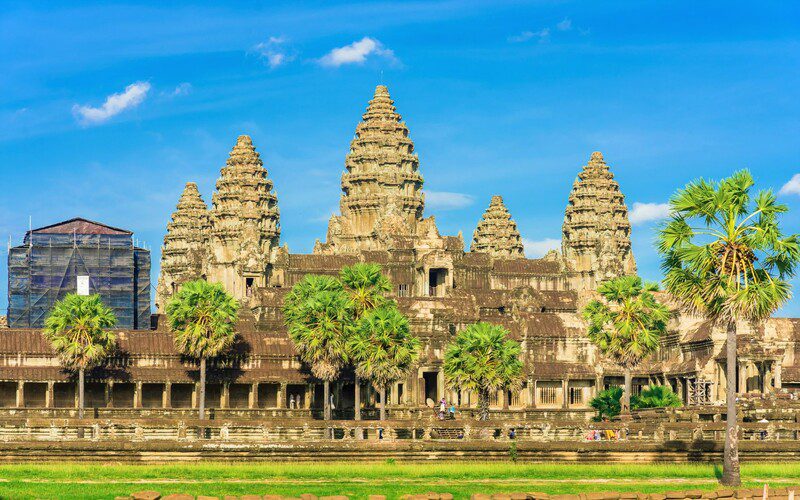Angkor is one of Indochina‘s most important archaeological sites. Angkor Thom is located in Angkor Archaeological Park, which covers 400 km2 and includes a forested area, and contains the magnificent remains of the Khmer Empire’s various capitals from the 9th to the 15th centuries.
General Information
Angkor Thom is an urban planning marvel and the name of one of Cambodia’s most impressive royal cities during the Angkor Period. “Angkor” means “city,” and “Thom” means “large,” so the name hints at what was once a great Khmer city.
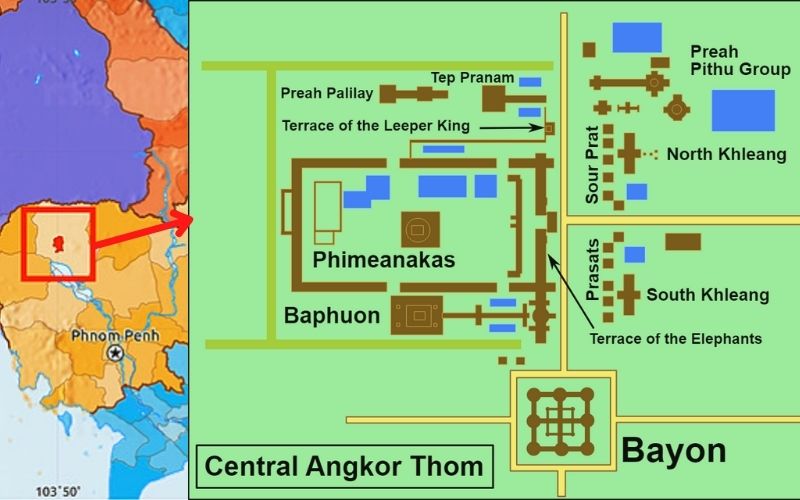
Map & Location of Angkor Thom
Angkor Thom is 9 square kilometers in size and is surrounded by a magnificent wall with five entrance gates. There are five monumental gates in the city, one on each of the north, west, and south walls, and two on the east wall. The 20-meter-high gates are adorned with stone elephant trunks on either side of the passageway and crowned by four gargantuan faces of the bodhisattva Avalokiteshvara. Except for the Bayon, all of the major sites are west or east of Victory Square. To the west, there is Baphuon, the Terrace of the Elephants, Phimeanakas, and the Royal Palace, the Terrace of the Leper King, Tep Pranam, and Preah Palilay; to the east, there is Prasat Suor Prat, South Khleang, and Preah Palilay.
Weather and best time to visit
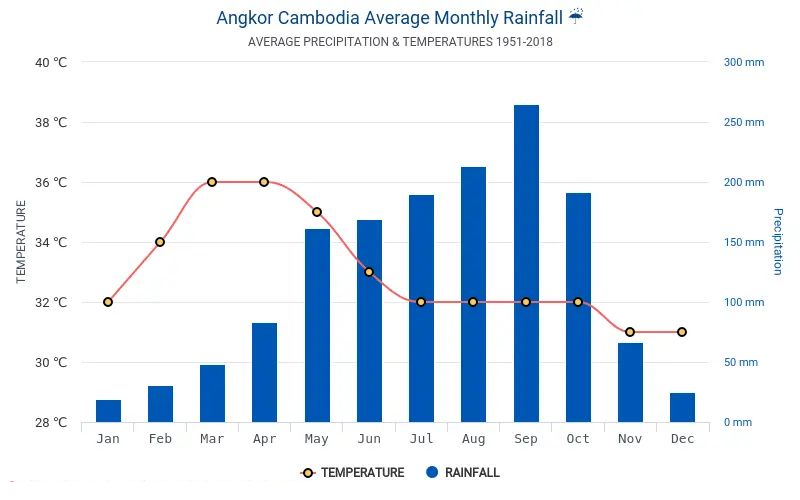
Angkor Thom weather
The rainy season begins in mid-April and lasts until October, with July and August being the wettest months. The advantages of gambling at this time of year are numerous. First and foremost, everything is less expensive. Second, the landscape is well-hydrated and has a brilliant green glow to it. Third, there will be fewer people in the way of your views of the temples.
However, you should be aware that during the monsoon season, when it rains, it pours. Your day of exploring may be cut short as you seek shelter from a sudden downpour.
The cool dry season, which lasts from November to mid-April, is thought to be the best time to visit Cambodia. Temperatures drop during this time, making the days cooler. This means you can spend extended periods of time outside without fear of getting heat stroke or drowning in your own sweat. The temperature will be in the mid-70s, with cool but not cold evenings.
However, for temple exploration, the wet season (May to October) is also a good time because the moats will be full and the foliage lush, albeit very soggy.
Getting to & around Angkor Thom
Angkor Thom’s southern gate is located 7 kilometers north of Siem Reap, past Angkor Wat. The complex is best explored by trekking, biking, and tuk-tuk, or as part of a temple tour by tuk-tuk, which conveniently transports you around. The best time to visit Angkor Thom is before sunrise when the majority of tourists are viewing Angkor Wat.
There are five gates to the inner city, each crowned with four giant faces, and a bridge extending over the moat to the outside area. Each sandstone tower stands 23 meters (75 feet) tall and is designed in a grandiose and elegant style. Some of the entrances have statues of goddesses and demons holding nagas.
Remember to purchase your Angkor Archaeological Park ticket in advance to avoid standing in line on the day of your visit. The main ticket sales office is the Angkor Conservation Area ticket booth on the road between Siem Reap and Angkor Wat. There are also many travel consultants who offer car booking services as well as the entire Angkorian tour.
Angkor National Park opens from 7:30 a.m. to 5:30 a.m., but Angkor Thom opens from 5:00 a.m. to 5:30 p.m., allowing for sunrise and sunset views.
Where to Stay in Angkor Thom
The temple complexes of Angkor (the former capital) have only a few restaurants and no accommodations, so visitors must stay in nearby Siem Reap to see the sights.
There are some low-cost hostels available, as well as other excellent options such as traditional homestays, villas, and even high-end hotels and resorts. You should book a room ahead of time in case hotels are fully booked during peak season. Otherwise, look for some budget-friendly options that are far from the heart of Angkor Thom.
Best places to visit
Bayon
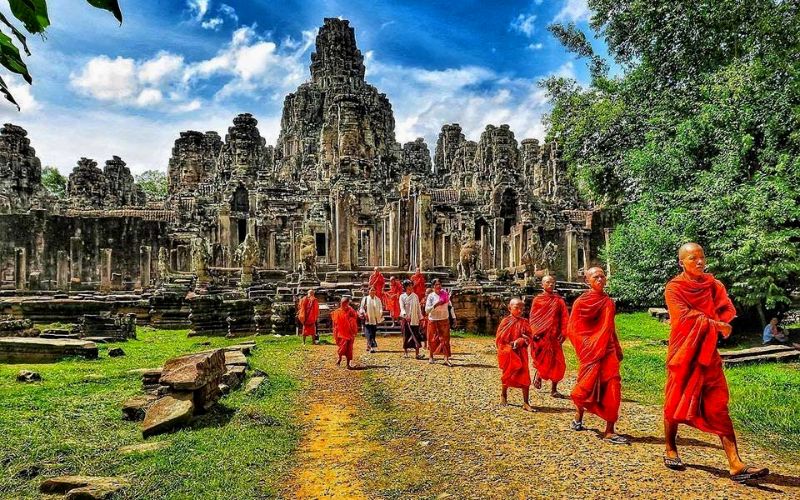
Bayonin
The state temple Bayon rises in the heart of Angkor Thom, a mesmerizing centerpiece to get lost in the mysteries with mazes of tunnels, blocked doorways, and tumble-down rocks. Bayon is divided into three levels, with several galleries on the first, historical and religious bas-reliefs on the second, and a central circular tower in distinctive Khmer architecture on the third. Bayon, on the other hand, will captivate you with its 216 smiling faces of Avalokiteshvara peering down at you.
Baphuon
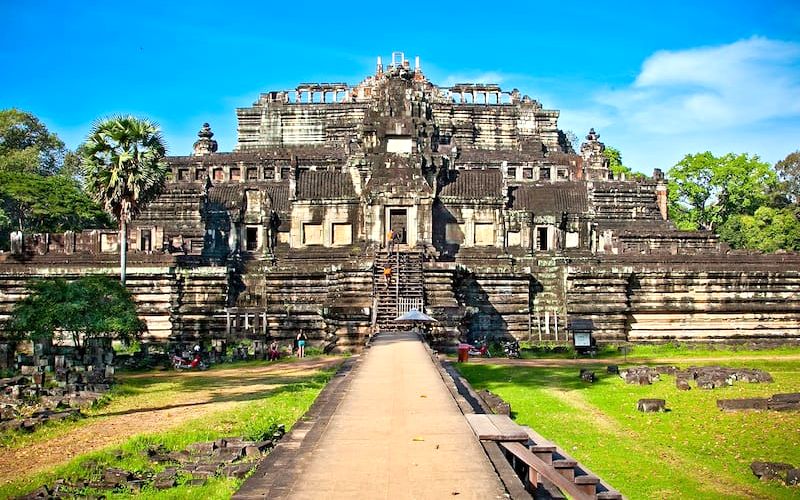
Baphuon
Baphuon was located 200 meters west of Bayon and was marked by a pyramidal representation of Mount Meru, which was probably the most impressive of the Angkor temples. A 200m elevated walkway leads to the temple, which has a 43m tall central tower.
Terrace of the Elephants
A royal terrace, called Terrace of the Elephants, features many statues and images of elephants on a 2.5-meter high and 350-meter long platform with five staircases. This site was supposedly used as a platform from which Jayavarman VII viewed his victorious returning army. Head to the north, stand a 7-meter-high Terrace of Leper King built in the late 12th century. On the top of the terrace, you will see a nude statue that is believed to represent one of two possible Angkorian Kings who had leprosy. It’s the reason for the site’s name is the finding of the “Leper King” statue.
Preah Paliliay
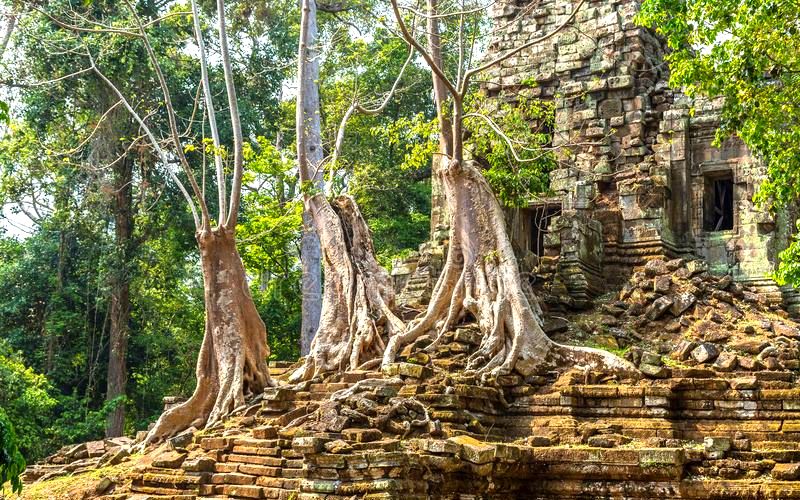
Preah Paliliay
In the northwest corner of the city, a lovely temple, Preah Paliliay, offers a tranquil atmosphere and great photo shots with huge trees looming over its structure. Another should-not-missed site is Phimeanakas which is more interesting historically than visually. Used to house a Royal Palace, where bathing would take place, there are still apparent pools but very little remains. Once you climb up its pyramidal structure, you’ll be rewarded with spectacular views of the surrounding area.
What to eat in Angkor Thom
Fish amok
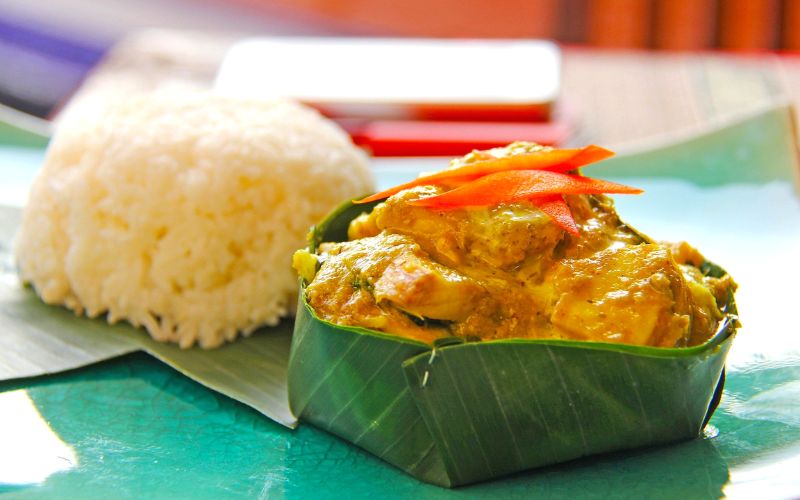
Fish Amok
This curry dish offers a melting and warm flavor that combines local herbs like ginger and lemon with a good dose of spice. In fact, this is one of the must-see dishes on your Cambodia tour.
Lok Lak (grilled beef)
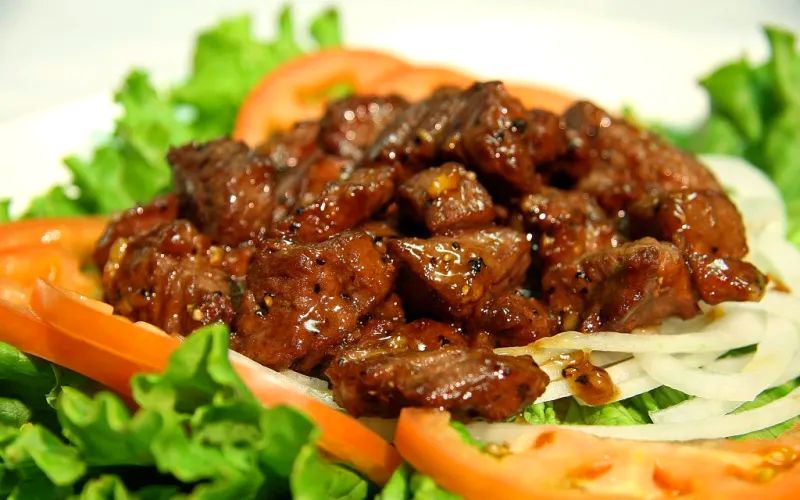
Lok Lak
This is another favorite dish of locals that you just can’t leave the city without trying once. The secret is in the overnight marinating of the beef before being stir-fried with a variety of herbs, veggies, and spices and is usually served with a tasty black pepper sauce along with steamed rice. It has influences from both French and Chinese cuisine mixed with a Khmer touch, and while you can find it overseas, there is nothing like the Lok Lak served by street vendors.
Samlor Korko
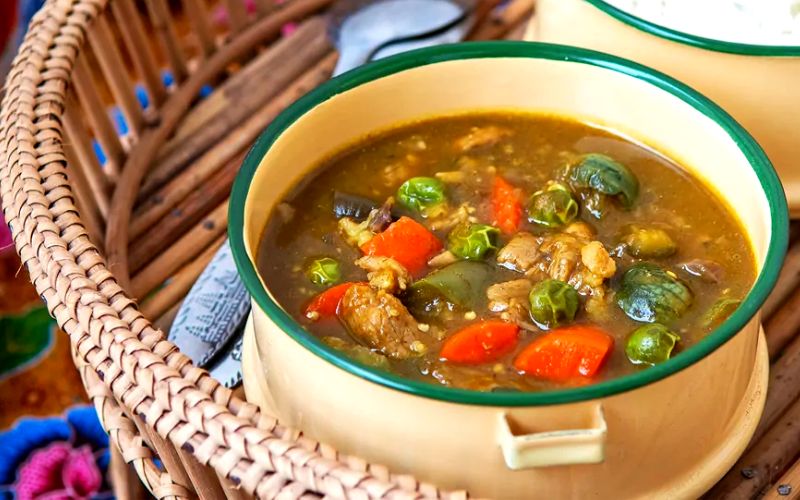
Samlor Korko
Samlor Korko is arguably the true national dish for the locals of Cambodia. Eaten for centuries and found on nearly every street corner in Angkor, this hearty, rich, and flavorful soup just does not miss. It’s probably one of the healthier options and you can even opt for a purely vegetarian option if meat is not your thing.
Lort Cha
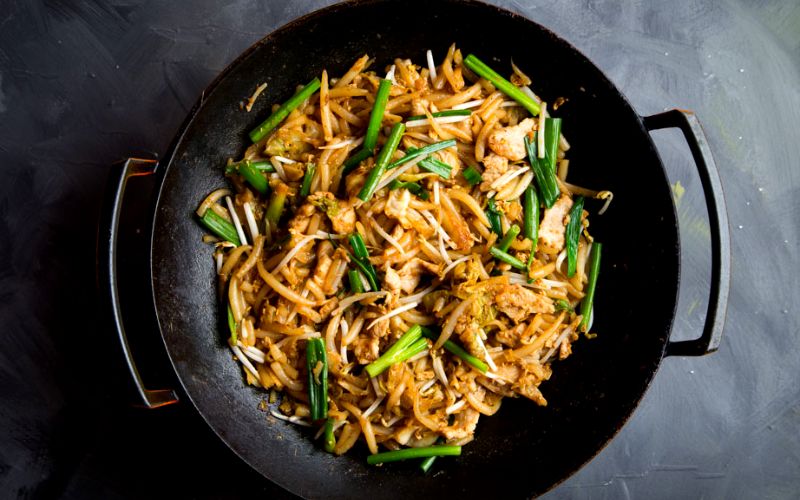
Lort Cha
Found at literally every corner in Cambodia, Lort Cha is a cheap, simple, yet seriously yummy street delight. Made of stir-fried rice noodles topped with minced vegetables and a fried egg and an option of pork, beef, or chicken, it captures the essence of Cambodian street food with its hassle-free yet rustic taste. If you are in a hurry and need a quick bite to make you full, this is the go-to dish.
Travel tips
Touring the temples is a hot and sweaty job, so wear light, airy, covering clothing to protect yourself from the sun and mosquitoes. The sun can be intense so bring a hat, sunglasses, and perhaps sunscreen. Consider buying a traditional Khmer scarf (krama) to keep the sun off your neck. Carry a raincoat during the wet season, though you will probably only need it in the afternoon. You should have mosquito repellent for sunrise and sunset hours. Wear practical shoes for climbing narrow steps and walking on uneven surfaces.
We hope the information in the article “Angkor Thom travel guide” will be helpful to you. If you want to have more information and ideas to build an unforgettable itinerary in Angkor Thom, do not hesitate to contact us!
Start planning your tailor-made tour with 1-1 help from our travel advisors.
- Plan your tailor - made trip with a local expert
- Book securely with money-back guarantee
- Travel stress-free with local 24/7 support
